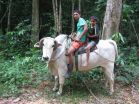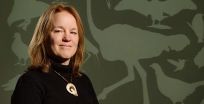(Press-News.org) A team of researchers led by North Carolina State University has found that stacking materials that are only one atom thick can create semiconductor junctions that transfer charge efficiently, regardless of whether the crystalline structure of the materials is mismatched - lowering the manufacturing cost for a wide variety of semiconductor devices such as solar cells, lasers and LEDs.
"This work demonstrates that by stacking multiple two-dimensional (2-D) materials in random ways we can create semiconductor junctions that are as functional as those with perfect alignment" says Dr. Linyou Cao, senior author of a paper on the work and an assistant professor of materials science and engineering at NC State.
"This could make the manufacture of semiconductor devices an order of magnitude less expensive."
For most semiconductor electronic or photonic devices to work, they need to have a junction, which is where two semiconductor materials are bound together. For example, in photonic devices like solar cells, lasers and LEDs, the junction is where photons are converted into electrons, or vice versa.
All semiconductor junctions rely on efficient charge transfer between materials, to ensure that current flows smoothly and that a minimum of energy is lost during the transfer. To do that in conventional semiconductor junctions, the crystalline structures of both materials need to match. However, that limits the materials that can be used, because you need to make sure the crystalline structures are compatible. And that limited number of material matches restricts the complexity and range of possible functions for semiconductor junctions.
"But we found that the crystalline structure doesn't matter if you use atomically thin, 2-D materials," Cao says. "We used molybdenum sulfide and tungsten sulfide for this experiment, but this is a fundamental discovery that we think applies to any 2-D semiconductor material. That means you can use any combination of two or more semiconductor materials, and you can stack them randomly but still get efficient charge transfer between the materials."
Currently, creating semiconductor junctions means perfectly matching crystalline structures between materials - which requires expensive equipment, sophisticated processing methods and user expertise. This manufacturing cost is a major reason why semiconductor devices such as solar cells, lasers and LEDs remain very expensive. But stacking 2-D materials doesn't require the crystalline structures to match.
"It's as simple as stacking pieces of paper on top of each other - it doesn't even matter if the edges of the paper line up," Cao says.
INFORMATION:
The paper, "Equally Efficient Interlayer Exciton Relaxation and Improved Absorption in Epitaxial and Non-epitaxial MoS2/WS2 Heterostructures," was published as a "just-accepted" manuscript in Nano Letters Dec. 3.
Lead authors of the paper are Yifei Yu, a Ph.D. student at NC State; Dr. Shi Hu, a former postdoctoral researcher at NC State; and Liqin Su, a Ph.D. student at the University of North Carolina at Charlotte. The paper was co-authored by Lujun Huang, Yi Liu, Zhenghe Jin, and Dr. Ki Wook Kim of NC State; Drs. Alexander Purezky and David Geohegan of Oak Ridge National Laboratory; and Dr. Yong Zhang of UNC Charlotte. The research was funded by the U.S. Army Research Office under grant number W911NF-13-1-0201 and the National Science Foundation under grant number DMR-1352028.
Agricultural decisions made by our ancestors more than 10,000 years ago could hold the key to food security in the future, according to new research by the University of Sheffield.
Scientists, looking at why the first arable farmers chose to domesticate some cereal crops and not others, studied those that originated in the Fertile Crescent, an arc of land in western Asia from the Mediterranean Sea to the Persian Gulf.
They grew wild versions of what are now staple foods like wheat and barley along with other grasses from the region to identify the traits that make some ...
GAINESVILLE, Fla. --- Nature abhors a vacuum, which may explain the findings of a new study showing that bird evolution exploded 65 million years ago when nearly everything else on earth -- dinosaurs included -- died out.
The study is part of an ambitious project, published in today's issue of the journal Science, in which hundreds of scientists worldwide have decoded the avian genome.
Edward Braun, an evolutionary geneticist at the University of Florida and the UF Genetics Institute, is one of the key scientists who took part in this multi-year project that used nine ...
(Santa Barbara, Calif.) -- With more and more rainforest giving way to pasture and grazing land every year, the practice of cattle ranching in the Amazon has serious implications on a global scale. At the same time, however, it provides a degree of socioeconomic flexibility for Amazonian smallholders who simply can't survive on what the forest or agriculture provide.
In a paper published in the current issue of the journal Human Organization, UC Santa Barbara anthropologist Jeffrey Hoelle takes a look at the rise of cattle ranching in the Brazilian state of Acre and the ...
Astronomers using the Atacama Large Millimeter/submillimeter Array (ALMA) may have detected the dusty hallmarks of an entire family of Pluto-size objects swarming around an adolescent version of our own Sun.
By making detailed observations of the protoplanetary disk surrounding the star known as HD 107146, the astronomers detected an unexpected increase in the concentration of millimeter-size dust grains in the disk's outer reaches. This surprising increase, which begins remarkably far -- about 13 billion kilometers -- from the host star, may be the result of Pluto-size ...
COLUMBUS, Ohio - If dieting is on your New Year agenda, it might pay to be mindful of a study suggesting there is little hard evidence that mindfulness leads to weight loss.
Ohio State University researchers reviewed 19 previous studies on the effectiveness of mindfulness-based programs for weight loss. Thirteen of the studies documented weight loss among participants who practiced mindfulness, but all lacked either a measure of the change in mindfulness or a statistical analysis of the relationship between being mindful and dropping pounds. In many cases, the studies ...
BOSTON (December 11, 2014) -- A new study from epidemiologists at Tufts University School of Medicine helps to identify communities with the greatest public health need in Massachusetts for resources relating to HIV/AIDS and hepatitis C. The study, published today in PLOS ONE, used geospatial techniques to identify hotspots for deaths related to HIV/AIDS and hepatitis C. The findings show large disparities in death rates exist across race and ethnicity in Massachusetts.
The HIV/AIDS and hepatitis C epidemics are challenging public health officials and clinicians in the ...
BALTIMORE, December 11, 2014 - Insilico Medicine along with scientists from Vision Genomics and Howard University shed light on AMD disease, introducing the opportunity for eventual diagnostic and treatment options.
The scientific collaboration between Vision Genomics, Inc., Howard University, and Insilico Medicine, Inc., has revealed encouraging insight on the AMD disease using an interactome analysis approach. Resources such as publicly available gene expression data, Insilico Medicine's original algorithm OncoFinderTM, and AMD MedicineTM from Vision Genomics allowed ...
How much protection the annual flu shot provides depends on how well the vaccine (which is designed based on a "best guess" for next season's flu strain) matches the actually circulating virus. However, it also depends on the strength of the immune response elicited by the vaccine. A study published on December 11th in PLOS Pathogens reports that genetic variants in a gene called IL-28B influence influenza vaccine responses.
Adrian Egli, from the University of Basel, Switzerland, and colleagues started with blood samples from organ transplant patients. Such patients are ...
New circulating metabolites might allow early diagnosis of cardiovascular disease. A team of scientists from Uppsala University, Karolinska Institutet and Colorado State University have identified novel lipid-derived molecules associated with future coronary heart disease events. The study published in the journal PLOS Genetics has examined the metabolic profile of blood samples from more than 3,600 individuals that have been followed-up for up to 10 years.
Professor Erik Ingelsson and graduate student Andrea Ganna have used novel biochemical and bioinformatics approaches ...
CHAMPAIGN, Ill. -- An international effort involving more than 100 researchers, nine supercomputers and about 400 years of CPU time has yielded the most reliable avian tree of life yet produced, researchers report in the journal Science. The tree reflects the evolutionary relationships of 48 species of birds.
The paper describing the bird family tree is one of eight articles on avian evolution published together in Science. The overall endeavor was coordinated by Erich Jarvis of Duke University; M. Thomas P. Gilbert of the Natural History Museum of Denmark; and Guojie ...



